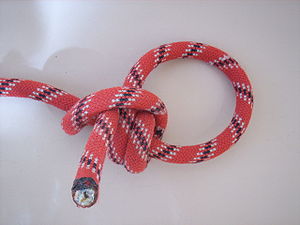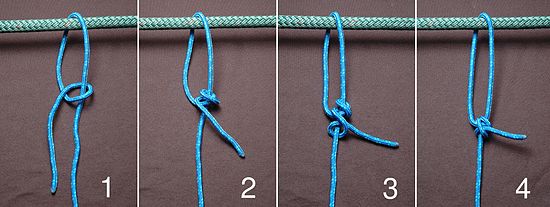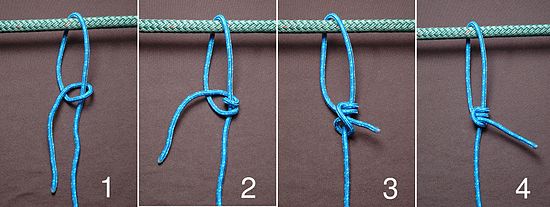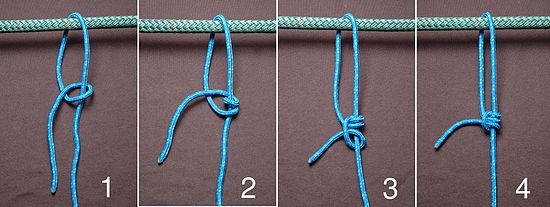- Taut-line hitch
-
Taut-line hitch Names Taut-line hitch, Adjustable hitch, Rigger's hitch, Midshipman's hitch, Tent-line hitch, Tent hitch Category Hitch Related Rolling hitch, Two half-hitches, Trucker's hitch, Adjustable grip hitch ABoK #62, #1027, #1230, #1729, #1730, #1799, #1800, #1855, #1856, #1857, #1993 The taut-line hitch is an adjustable loop knot for use on lines under tension. It is useful when the length of a line will need to be periodically adjusted in order to maintain tension. It is made by tying a rolling hitch around the standing part after passing around an anchor object. Tension is maintained by sliding the hitch to adjust size of the loop, thus changing the effective length of the standing part without retying the knot.
It is typically used for securing tent lines in outdoor activities involving camping, by arborists when climbing trees,[1] for creating adjustable moorings in tidal areas,[2] and to secure loads on vehicles. A versatile knot, the taut-line hitch was even used by astronauts during STS-82, the second Space Shuttle mission to repair the Hubble Space Telescope.[3]
Contents
Naming
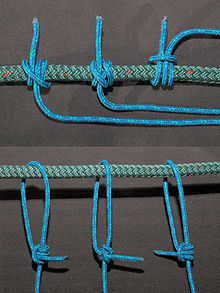 Top, left to right: ABOK "Rolling hitch(1)"(#1734), "rolling hitch(2)"(#1735), "Magnus Hitch"(#1736). Bottom, the corresponding adjustable loop made using the hitch above it, left to right: "adjustable hitch"(#1800, #1856), "midshipman's hitch"(#1855), "adjustable hitch" with the concluding hitch reversed.(#1857)
Top, left to right: ABOK "Rolling hitch(1)"(#1734), "rolling hitch(2)"(#1735), "Magnus Hitch"(#1736). Bottom, the corresponding adjustable loop made using the hitch above it, left to right: "adjustable hitch"(#1800, #1856), "midshipman's hitch"(#1855), "adjustable hitch" with the concluding hitch reversed.(#1857)
The adjustable loop forms of the rolling hitch and Magnus hitch, in addition to being called either of those two names, have also come to be known variously as the taut-line hitch,[2] tent-line hitch,[2] rigger's hitch,[2] adjustable hitch,[4] or midshipman's hitch.[4] These knots are generally shown as being based on one of three underlying hitches: two variants of the rolling hitch (ABOK #1734 and #1735) and the Magnus hitch (#1736).
These three closely related hitches have a long and muddled naming history that leads to ambiguity in the naming of their adjustable loop forms as well. The use of the Ashley reference numbers for these inconsistently named hitches can eliminate ambiguity when required. See the image to the right for an illustration of these related knots.
An early use of the taut-line hitch name is found in A.A. Burger's 1914 Rope and Its Uses, although it is shown in the rolling hitch form as a stopper.[5]
Tying
#1855
Ashley uses the name midshipman's hitch for this variation. Based on rolling hitch #1735, this version is considered the most secure but may be more difficult to adjust after being heavily loaded.
- Pass the working end around the anchor object. Bring it back alongside of the standing part and make a half-hitch around the standing part.
- Continue by passing the working end over the working part, around the standing part again and back through the loop formed in the first step. Make sure this second wrap tucks in between the first wrap and the working part of the line on the inside of the loop. This detail gives this version its additional security.
- Complete with a half-hitch outside the loop, made in the same direction as the first two wraps, as for a clove hitch.
- Dress by snugging the hitch firmly around the standing part. Load slowly and adjust as necessary.
#1856
Based on rolling hitch #1734, this version is the one most often seen named taut-line hitch, commonly in non-nautical sources. It is the method currently taught by the Boy Scouts of America,[6] although older handbooks show #1855 under the taut-line hitch name.[7]
- Pass the working end around the anchor object. Bring it back alongside of the standing part and make a half-hitch around the standing part.
- Continue with another wrap inside the loop, effectively making a round turn around the standing part.
- Complete with a half-hitch outside the loop, made in the same direction as the first two wraps, as for a clove hitch.
- Dress by snugging the hitch firmly around the standing part. Load slowly and adjust as necessary.
#1857
Based on Magnus hitch #1736, this is exactly as above but with the final hitch in the opposite direction. It can be more tricky to snug-up, since both lines emerge from the same side of the hitch, but it has less tendency to twist under load.
- Pass the working end around the anchor object. Bring it back alongside of the standing part and make a half-hitch around the standing part.
- Continue with another wrap inside the loop, effectively making a round turn around the standing part.
- Complete with a half-hitch outside the loop made in the opposite direction than the first two wraps, as for a cow hitch.
- Dress by snugging the hitch firmly around the standing part. Load slowly and adjust as necessary.
Adjusting
Once snug and set, the hitch can be adjusted as needed. To tighten the line with respect to a load attached to the standing part, grasp the standing part with one hand inside of the loop and pull towards the anchor object. Grasp the hitch with the other hand and as slack develops within the loop slide the hitch away from the anchor object, taking up the slack and enlarging the loop. To loosen, slide hitch toward the anchor object, making the loop smaller and lengthening the standing part.
Security
Although the three variations are similar they do have distinct properties when put to use. Ashley[8] and others[2][9][10] suggest that #1855 is preferred as being more secure. Either #1856 or #1857 is also acceptable, especially if ease of adjustment is desired over security.[11] Ashley states #1857 has less tendency to twist.[4]
These hitches should not be depended on to hold fast under all conditions. With lines made from particularly stiff or slick modern fibers (e.g. polypropylene) these hitches can be difficult to make hold at all. Sometimes they can be made more secure by using additional initial wraps and finishing half-hitches.[11]
See also
References
- ^ Mark Adams, Son of a Hitch: A Genealogy of Arborists' Climbing Hitches. http://www.treebuzz.com/pdf/0505_geneology.pdf
- ^ a b c d e Brion Toss, The Complete Rigger's Apprentice (Camden: International Marine, 1998), 54-55.
- ^ Tom Nugent, "Blanketing the Hubble", University of Delaware Messenger, vol. 6, no.3 (1997) http://www.udel.edu/PR/Messenger/97/3/BLANKET.html
- ^ a b c Clifford W. Ashley, The Ashley Book of Knots (New York: Doubleday, 1944), 304.
- ^ A.A. Burger (1914). "Rope and Its Uses". Extension Bulletin 24 (Ames: Iowa State College of Agricultural and Mechanic Arts) XIII (8): 31. http://books.google.com/books?id=Ju4sAAAAYAAJ&pg=RA1-PA31#v=onepage&q&f=false. Retrieved 2011-04-26.
- ^ Boy Scouts of America, The Boy Scout Handbook, 11th ed. (Irving: BSA, 1998), 37.
- ^ Boy Scouts of America, Handbook for Boys, 5th ed., (BSA, 1949), 94-95.
- ^ Ashley, 298.
- ^ Nola Trower, Helmsman Guides: Knots and Ropework (Wiltshire: Helmsman Books, 1995), 31-32.
- ^ Animated Knots by Grog. Rolling Hitch. http://www.animatedknots.com/rollinghitchboating/
- ^ a b Brion Toss, Chapman's Nautical Guides: Knots (New York: Hearst Marine Books, 1990), 30-32.
Categories:- Hitch knots
Wikimedia Foundation. 2010.

